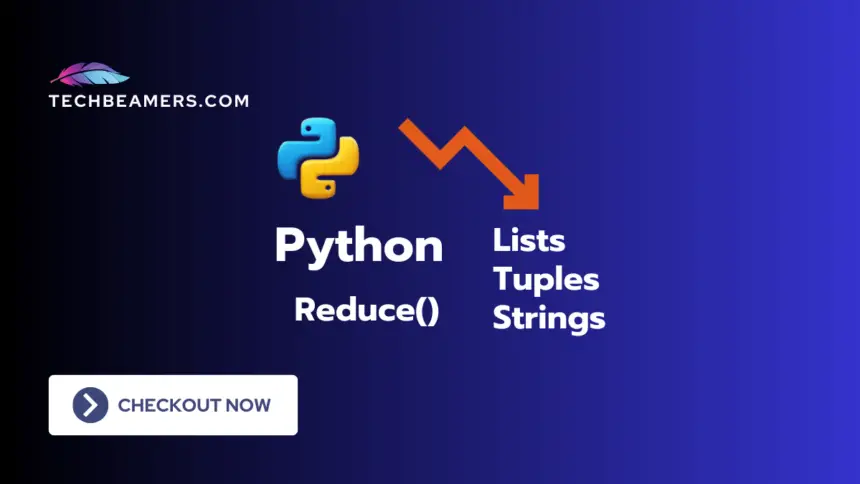The reduce() function in Python is handy for combining or filtering values in a list. It works by repeatedly using a function on pairs of elements, gradually producing a final result. For example, if we are reducing a list of numbers, reduce() can find sums, products, or other custom calculations. At the same time, it shrinks the list until only one value is left, making tasks like finding the biggest or smallest number easier. On the other hand, when we accumulate, take a case where we want to concatenate strings in a list. Depending on our goal, we can either build up a result or simplify a list using reduce().
Python Reduce() Explained with Examples
The reduce() function in Python belongs to the functools module. It iteratively applies a binary function to the items of an iterable, ultimately producing a single accumulated result. A binary function is a shorthand function that takes two arguments.
Reduce() Syntax
Here is the syntax for the Python reduce() function.
from functools import reduce as reducing
result = reducing(binary_func, seq, init_val=None)In the above syntax, the meaning of each argument is as follows:
binary_func: It is the function that is used for reducing the list.seq: The iterable (e.g., list, tuple) that the function will reduce.init_val(optional): If present, it serves as the first argument to the first call of the function.
Please note that The reduce() function can raise a TypeError if the iterable is empty, and no initial value is provided.
Understanding reduce()
Let’s discover a few key facts about the reduce() function.
- It’s a higher-order function in Python, meaning it takes a function as an argument.
- It loops through a list (or similar iterable), applying the given function to progressively combine its values into a single result.
- It’s available in various programming languages, including Python, JavaScript, and others.
Example – Reducing a List with Reduce()
Let’s consider a scenario where we have a list of prices, and we want to find the total discounted price after applying a discount function using reduce():
from functools import reduce as rd
# List of prices
prices = [100, 50, 30, 80, 120]
# Discount function (e.g., 10% off)
def apply_discount(total, price):
return total - (price * 0.1)
# Using reduce to find the discounted total
discounted_total = rd(apply_discount, prices)
print("Original Total:", sum(prices))
print("Discounted Total:", discounted_total)Common Use Cases for Using Python Reduce()
There can be many programming problems in Python that we can solve using the reduce() function.
1. Finding Maximum/Minimum Values
Find the maximum (or minimum) value in a list using the reduce() function in Python. Iterate through the list, comparing elements to gradually determine the maximum (or minimum) value.
from functools import reduce
# List of numbers
numbers = [3, 8, 1, 6, 4]
# Finding the maximum value
max_value = reduce(lambda x, y: x if x > y else y, numbers)
print("Maximum Value:", max_value)This code demonstrates how to use reduce() to find the maximum value in a list of numbers. Adjust the lambda function accordingly to find the minimum value.
2. Calculating Sums
Calculate the sum of values in a list using the reduce() function in Python. Iterate through the list, adding elements together to obtain the cumulative sum.
from functools import reduce
# List of numbers
numbers = [1, 2, 3, 4, 5]
# Calculating the sum
sum_result = reduce(lambda x, y: x + y, numbers)
print("Sum:", sum_result)This code showcases the use of reduce() to efficiently calculate the sum of values in a list. Adjust the lambda function for different aggregation operations.
3. Calculating Products
Compute the product of values in a list using the reduce() function in Python. Iterate through the list, multiplying elements together to obtain the cumulative product.
from functools import reduce
# List of numbers
numbers = [2, 3, 4, 5]
# Calculating the product
product_result = reduce(lambda x, y: x * y, numbers)
print("Product:", product_result)This code demonstrates how to leverage reduce() to find the product of values in a list. Adjust the lambda function as needed for other multiplication-based operations.
4. Finding Averages
Find the average of values in a list using the reduce() function in Python. Iterate through the list, summing the elements and dividing by the total number of items.
from functools import reduce
# List of numbers
numbers = [10, 20, 30, 40, 50]
# Finding the average
average_result = reduce(lambda x, y: x + y, numbers) / len(numbers)
print("Average:", average_result)This code illustrates using reduce() to calculate the average of values in a list. Adapt the lambda function accordingly for diverse averaging scenarios.
5. Concatenating Strings
Concatenate a list of strings into a single string using the reduce() function in Python. Iterate through the list, combining elements to create a unified string.
from functools import reduce
# List of strings
words = ["Hello", " ", "World", "!"]
# Concatenating strings
concatenated_result = reduce(lambda x, y: x + y, words)
print("Concatenated Result:", concatenated_result)This code demonstrates the application of reduce() to concatenate strings in a list, producing a cohesive string. Modify the lambda function as needed for different string concatenation requirements.
6. Filtering Elements
Filter elements in a list based on a condition using the reduce() function in Python. Iterate through the list, applying a filtering function to selectively include elements in the final result.
from functools import reduce
# List of numbers
numbers = [1, 2, 3, 4, 5, 6, 7, 8, 9, 10]
# Filtering even numbers
filtered_result = reduce(lambda acc, x: acc + [x] if x % 2 == 0 else acc, numbers, [])
print("Filtered Result:", filtered_result)This code above is reducing a list with reduce() by filtering elements in a list, keeping only those that satisfy a specified condition. If we need, we can adjust the lambda function to opt for different filtering criteria.
7. Mapping Data
Map a transformation function to each element in a list using the reduce() function in Python. Iterate through the list, applying the mapping function to transform each element.
from functools import reduce
# List of numbers
numbers = [1, 2, 3, 4, 5]
# Mapping elements to their squares
mapped_result = reduce(lambda acc, x: acc + [x**2], numbers, [])
print("Mapped Result:", mapped_result)This code illustrates the use of reduce() for mapping a transformation function to each element in a list, resulting in a new list of transformed values. Modify the lambda function for different mapping scenarios.
8. Reducing a Tuple
Let’s take a use case where we have a tuple containing the durations of various tasks, and we want to find the total duration by reducing the tuple.
from functools import reduce
# Tuple of task durations (in hours)
task_durations = (2, 3, 1, 4, 2)
# Reducing the tuple to find the total duration
total_duration = reduce(lambda x, y: x + y, task_durations)
print("Total Duration:", total_duration)In this example, the reduce() function is used to calculate the total duration of tasks represented by a tuple. The lambda function adds each duration cumulatively. Adjust the tuple elements based on your specific task durations.
Conclusion
Reduce() in Python is flexible for various tasks, going beyond common uses. It supports functional programming principles of using higher-order functions to avoid side effects. When deciding between reduce() and alternatives like loops or built-in functions, keep readability in mind for clearer and more straightforward code.
In case you have queries or suggestions, don’t hesitate to share them with us. Use the comment box and let us know.
Happy Coding,
Team TechBeamers









